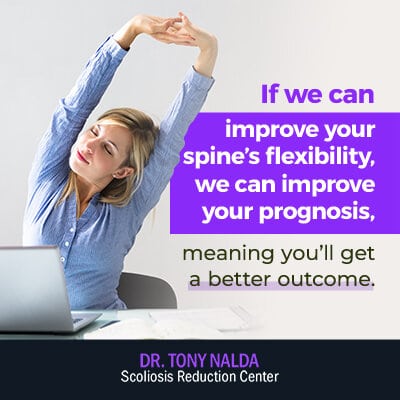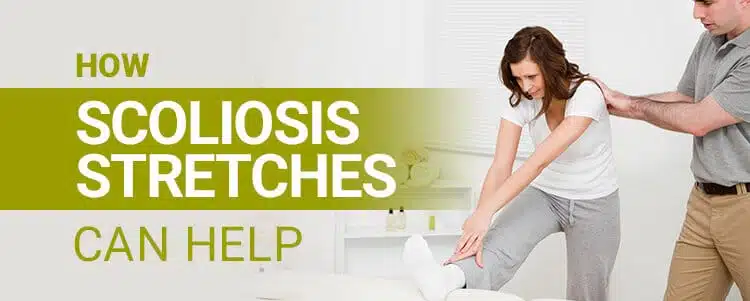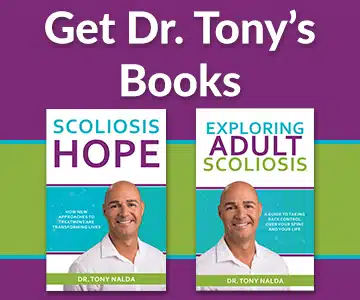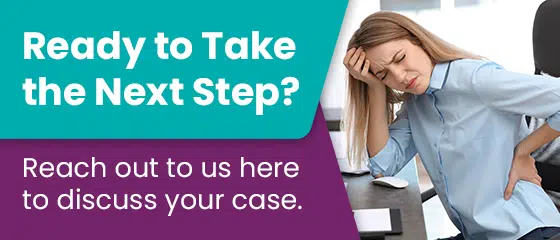The most common form of scoliosis has no known single cause – adolescent idiopathic scoliosis – and is thought to be caused by multiple variables. Just as its causation involves multiple factors, an effective treatment approach should be multifaceted and include various disciplines. Within that arena of scoliosis-treatment options, it’s important to fully understand how stretches for scoliosis can help; this ensures they are being done correctly and recruiting the right vertebrae of the spine.
There are two main types of scoliosis stretches: back stretches for scoliosis that are specifically for the spine, and stretches for the extremities/limbs that are associated with scoliosis. Before we get into the specifics of each type, let’s first ensure you have a basic understanding of how scoliosis affects the spine.
Understanding the Scoliotic Spine
In early-onset scoliosis, most curvatures tend to be quite flexible, meaning the area of the spine with the scoliosis doesn’t have significant rigidity. This means the spine has a typical range of motion.

Even in a spine that has recently developed scoliosis but has a normal range of motion, there do tend to be some restrictions in the apex of each curvature, and it’s these restrictions we are trying to improve upon with scoliosis exercises and stretches.
When scoliosis exercises and stretches are done correctly, the specific vertebrae with the rigidity issues are targeted, engaged, and that area’s flexibility will be increased.
Flexibility and Stretches
Decreasing the rigidity of the scoliosis spine by increasing flexibility is a big component of treatment efficacy. This is why it’s so important to initiate active treatment as close to the time of diagnosis as possible; at this time, the condition is in its mildest form, prior to progression, and will be at its most flexible.
A spine that’s more flexible is easier to manipulate, meaning there is a much faster response time to treatment, and it’s a simpler process to achieve a curvature reduction.
Let’s discuss how exercises and stretches that are specifically for the spine improve its overall health and flexibility.
Types of Stretches for Scoliosis that Improve Flexibility
If a patient has a thoracic (middle back) curve or lumbar (lower back) curve, where the curve turns the other way, those vertebrae will have some restricted motion.
The best way to stretch that area and improve flexibility/mobility is by using one of the following five methods.
1) Bending in the Opposite Direction of the Curve
Bending in the curve’s opposite direction is an effective, sustainable, and simple stretch that can yield positive results.
This can be easily done from home, is prescribed by your doctor, and instructed by your doctor. Instructions should include how to bend out of the scoliosis to help stretch those specific vertebrae to help increase the range of motion in those affected joints.
This is where working with a scoliosis specialist, rather than a general practitioner, is highly beneficial. Scoliosis specialists have a comprehensive understanding of how to assess the spine to determine which vertebrae are the most rigid, which stretches target those specific vertebrae, and how to engage them.
2) Using Home Equipment: Foam Fulcrums
The use of home equipment, such as foam fulcrums, can also be an effective way to stretch, maintain, and improve flexibility.
Foam fulcrums can be prescribed by your doctor or a scoliosis specialist who will be able to find the appropriate fulcrum for your scoliosis and teach you how to lay down on it and use it effectively.
When used correctly, these foam fulcrums can help achieve a passive stretch in the apex of the curve and increase flexibility.
3) Exercising and Stretching the Curve
We also have our patients do exercises while stretching the curve. This is a very powerful thing because when you stretch the spine in a corrective position, you’re also exercising associated muscles and doing two things at once.
These exercises are done while the spine is in a corrective position.
4) Traction Equipment
Specialized therapy and traction equipment, such as the CLEAR Scoliosis Institute traction chair, can be used to specifically pull at the apex of the scoliosis to help stretch all those affected joints and help increase flexibility and mobility.
5) Corrective Bracing
A well-designed corrective brace can also push the apex of the curve to actually open up the inside of the curve and help stretch it out.
Corrective bracing is not to be confused with supportive bracing. Supportive bracing has the goal of stopping progression, and it does this by ‘holding’ the spine in a corrective position; whereas corrective bracing actually works to ‘correct’ the curvature so the scoliosis is stabilized and reduced.
In an ideal treatment scenario, your scoliosis specialist would be including all the above components and coordinating them properly so that each stretch will work with the next one and so on.
That way, each and every stretch compiles and has a cumulative effect that allows for the largest gain of flexibility in the spine.
How Increasing Flexibility Leads to a Better Prognosis

Increasing flexibility is important for scoliosis patients because the more flexible the spine is, especially at the apex of the curve, the more we are able to get a reduction in the spine’s unhealthy curves and restore its healthy ones.
If we can improve your spine’s flexibility, we can improve your prognosis, meaning you’ll get a better outcome.
In later-stage life, the spine is vulnerable to the natural degenerative changes associated with aging, and this is especially true for elderly people living with the complication of scoliosis.
The older a person gets, the stiffer that apex becomes, and then it’s far more difficult for those above techniques to be executed properly to achieve those flexibility results.
The more rigid a spine is, the less positive the prognosis is going to be as it’s more difficult to achieve a curvature reduction and restore the spine’s biomechanics.
Now that we’ve discussed the role of scoliosis-specific exercises and stretches in treatment efficacy, let’s move on to how stretches can impact muscles that are associated with scoliosis.
Scoliosis-Related Muscle Tightness and Stretches
When a person develops scoliosis, their spine loses its healthy curves and replaces them with bad curves. The spine’s healthy curves facilitate its strength, flexibility, and ability to evenly distribute force throughout.
As the spine is such an integral part of human anatomy, when it becomes misaligned, it affects multiple areas of the body and impacts its overall symmetry.
Interestingly enough, because of the scoliosis spine’s asymmetry, there tends to be compensatory stiffness in associated limbs: glutes, hamstrings, quads, calves, and also the upper extremities such as the trapezius, shoulders, and arms.
Just as a typical scoliosis has an ‘S’ shape, that same shape happens in the positioning of the body. In a typical scoliosis with a right thoracic, left lumbar curve, that structural deformity will keep going down.
This means that the right glute will be experiencing tightness; the left hamstring will be experiencing tightness, and the right calf will be tight. Stretches that engage each one of these areas will help alleviate the tightness that is extending down from the scoliosis.
It’s opposite in the front, affecting the left psoas, right quad, and left tibia interior. Stretching each of these muscles specifically, along with basic glute, hamstring, quad, and gastrocnemius stretches, with home stretches can help reduce stiffness and increase flexibility of those affected limbs.
While exercises and stretches that specifically target these muscles help alleviate the stiffness that’s connected to the scoliosis in the spine, they do nothing for the spine itself, in terms of addressing its rigidity. They have more of a compensatory effect on the scoliosis.
This is why any effective exercise/stretching regime has to have a two-pronged approach: those that specifically target the spine, and those that specifically target associated muscles.
It’s the spine’s flexibility that is ultimately going to be the main determining factor of how well we can reduce your curvature and the likelihood of a positive prognosis.
How do I know if My Scoliosis Stretches are Helping?
When it comes to monitoring how your scoliosis is responding to the exercises and stretches, it’s only natural to want to know if your efforts are paying off; this is where some potential issues can emerge.
Often, when a person is first diagnosed with scoliosis or sent for additional testing to confirm a diagnosis, their treatment journey starts with their general practitioner. While there’s no harm in starting your treatment journey here, I highly recommend forking off and finding a scoliosis specialist certified in multiple modalities to be in charge of your scoliosis treatment.
Scoliosis is a complex condition, and even specialists still have a lot to learn and discover about it. A specialist is trained and experienced in diagnosing and treating scoliosis. They know how to read a scoliosis X-ray comprehensively, and X-rays are the main conduit for providing the information needed to treat the condition.
If you are seeing a general practitioner for your scoliosis treatment, it’s likely you are being prescribed general exercises and stretches that aren’t necessarily scoliosis-specific.
Where this becomes problematic is knowing which vertebrae are the most rigid and the most in need of being targeted to decrease their rigidity and increase their flexibility. General stretches for scoliosis upper back, middle back, or lower back might target those specific sections of the spine, but they’re not targeting the specific rigid vertebrae that are at the apex of the scoliosis curve.
Often, when general exercises and stretches are prescribed for scoliosis patients, there is a lack of knowledge on how to isolate the apex of the curve. Guidance will sound something like, “Okay, since your curvature bends to the left, just stretch to the right, and that should help naturally straighten the spine and correct the misalignment.”
Unless the specific vertebrae at the apex of the curve are targeted, the efficacy of exercises and stretches will only go so far as the area most in need of attention isn’t being properly engaged.
There is also the danger of worsening the curve. If you have a bottom curve, you can bend to make that curve worse, and this motion is easier for people with scoliosis to do, meaning it’s what they would naturally do.
The only way to truly know if your scoliosis stretches and exercises are helping is to monitor the rigidity of the affected vertebrae before, during, and after treatment.
How we Assess and Monitor Spinal Rigidity
Here at the Scoliosis Reduction Center®, we take X-rays while the patient is in a bending position, referred to as a ‘lateral bending X-ray’. With this, we can see how the patient moves to see where the most rigid areas of the spine are.
We also take X-ray images while they are in a corrective position, meaning while they are in the devices, laying on a foam fulcrum, or doing the prescribed exercises or stretches; we do this to ensure they are recruiting the correct area for optimum results.
While it might seem that bending to the right if you have a left curvature is the obvious thing to do, in terms of correction, this won’t be enough. The truth is general exercises and stretches don’t recruit the areas it needs to for corrective results.
Any effective exercise/stretching regime has to be scoliosis-specific because a scoliosis spine doesn’t move the same as a normal spine.
The easiest thing to do is bend into the concavity, not the convexity.
Conclusion
When it comes to effectively treating scoliosis, scoliosis-specific exercises and stretches can be very powerful treatment tools, if done correctly.
In order for them to be done in a way that will augment other treatment efforts made, such as chiropractic adjustments, the most rigid vertebrae at the apex of the curve have to be targeted and engaged.
It’s not enough to simply bend and stretch in the opposite direction of your curvature to address and correct the structural deformity that is scoliosis; your treatment plan needs to include various elements such as chiropractic adjustments, therapy, rehabilitation, and scoliosis-specific exercises/stretches that work towards increasing the spine’s flexibility.
When we work towards increasing the spine’s flexibility through scoliosis-specific exercises and stretches, we are working towards increasing our chances of achieving a curvature reduction and improving the patient’s prognosis.





